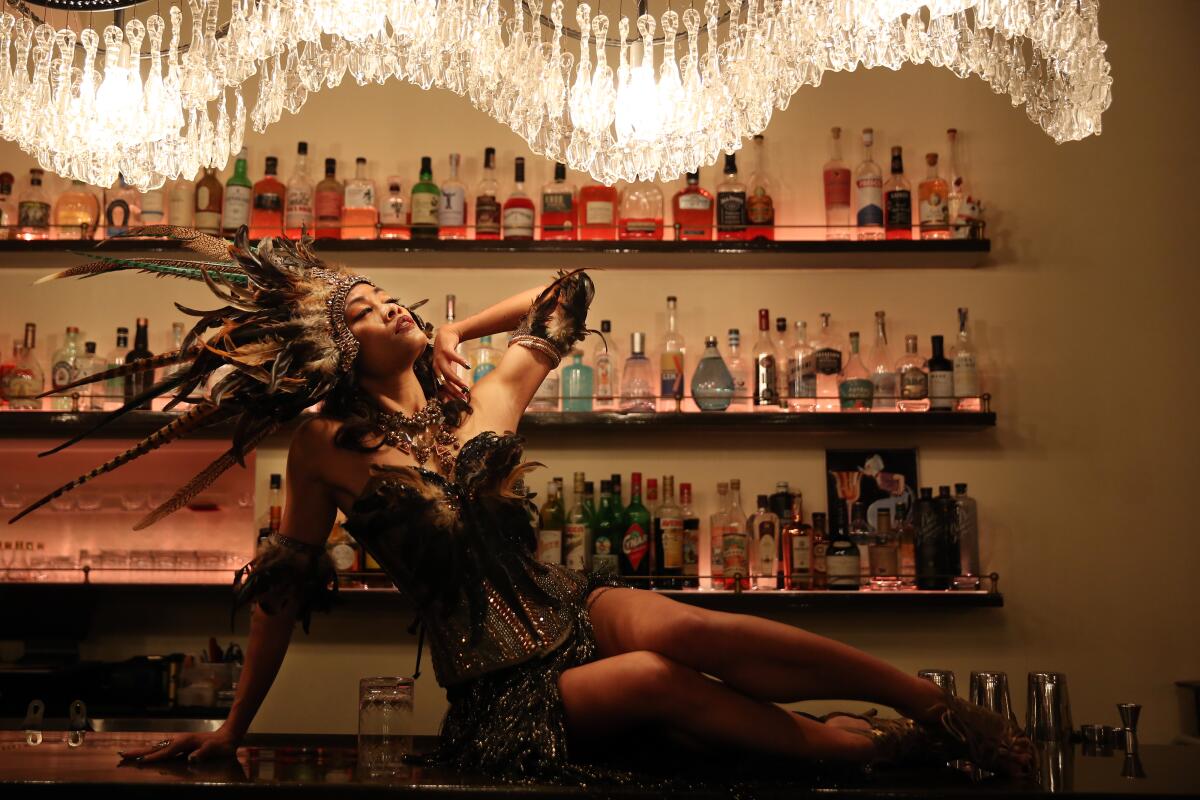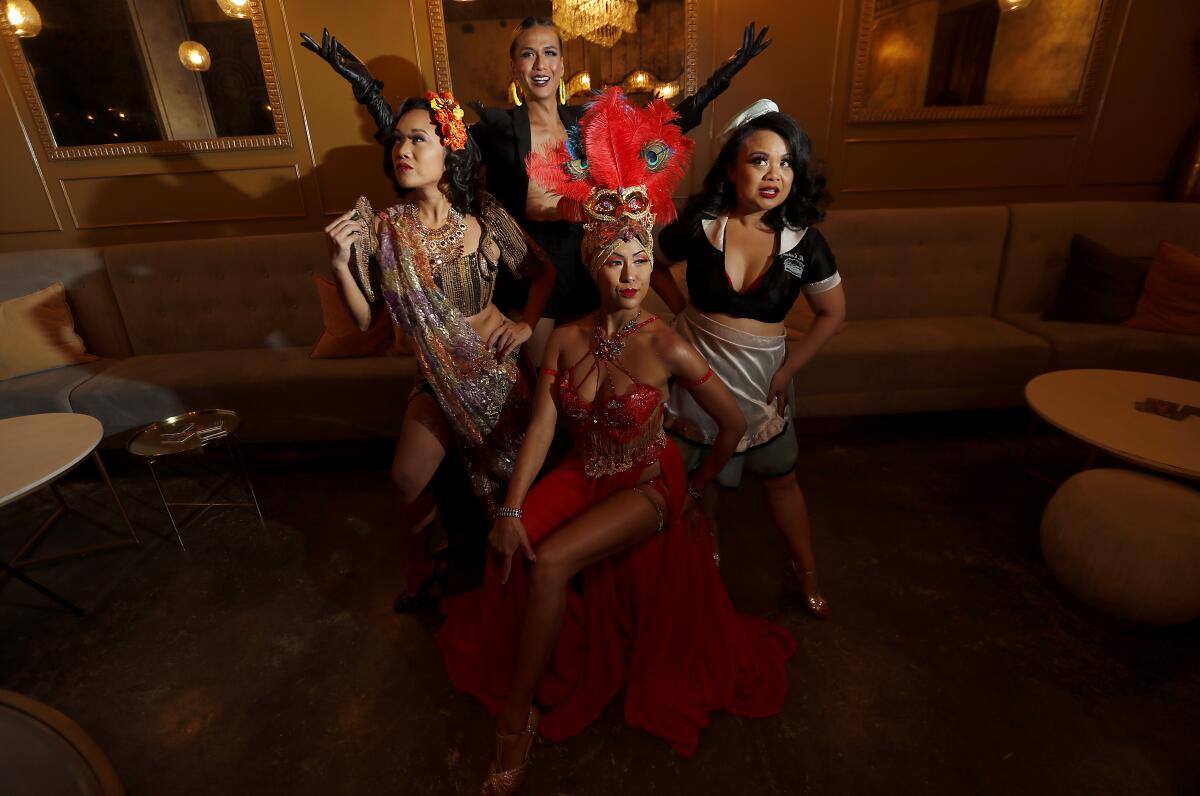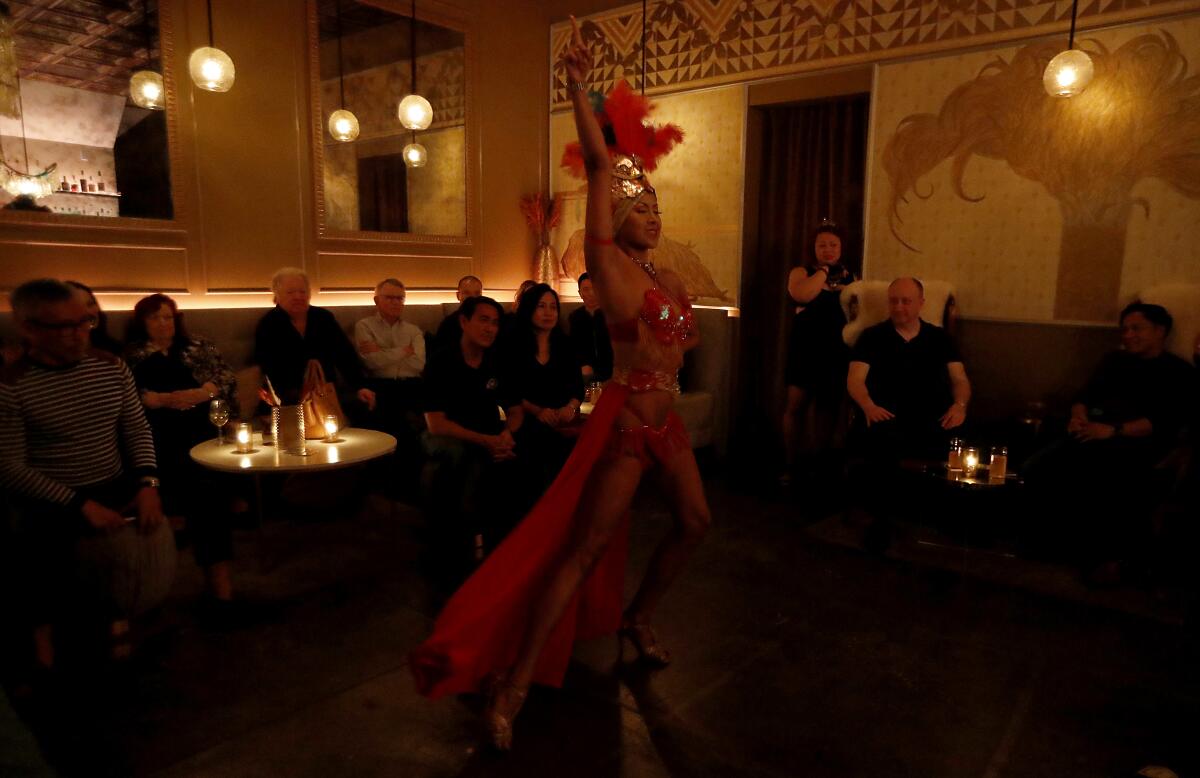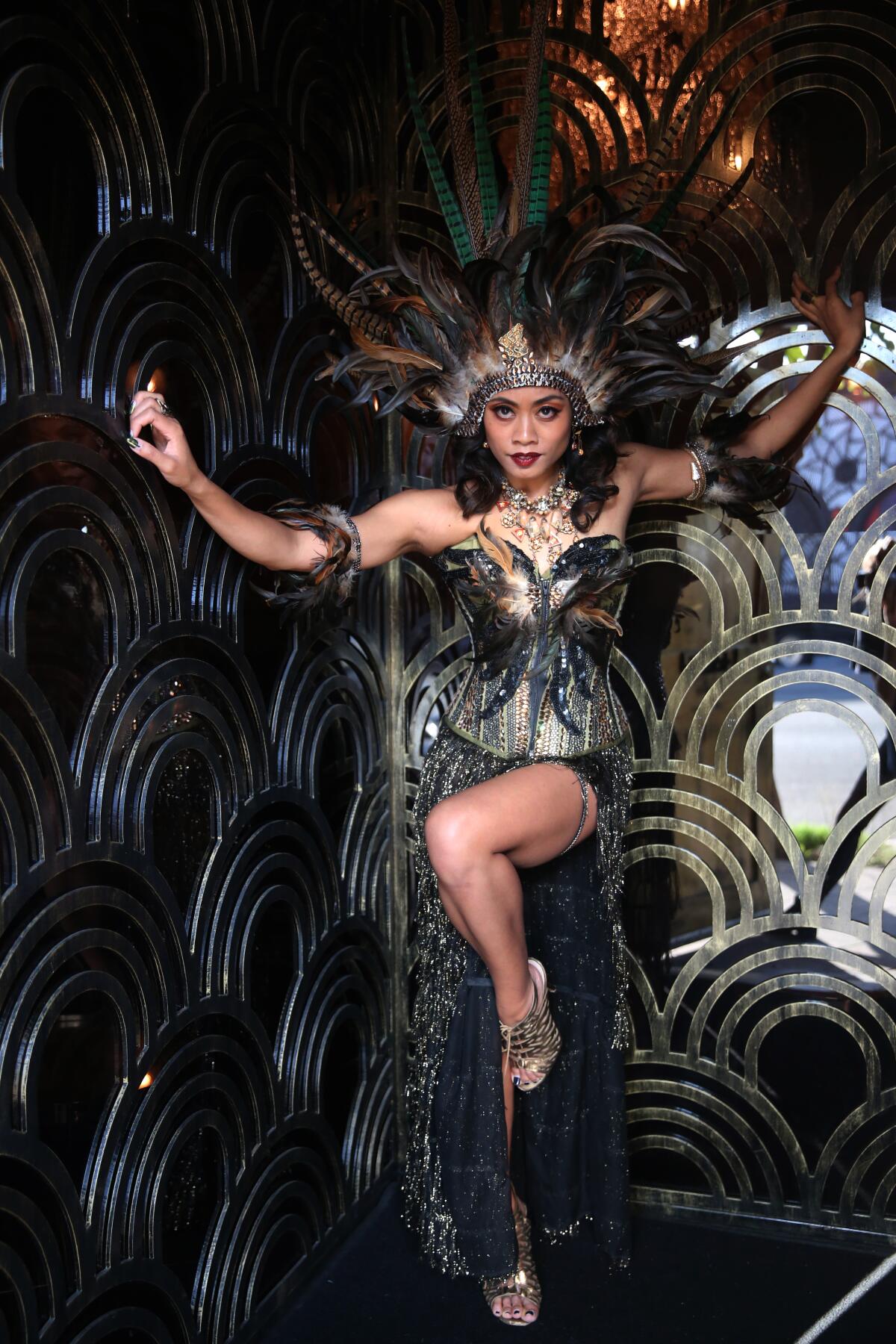Filipina burlesque show aims to break cultural barriers, two pasties at a time

“She has butt tassels!”
The exclamation can be heard over the music as a burlesque dancer known as Lady Mabuhay sheds her skirt in preparation for her act’s crescendo: She spins the aforementioned tassels in direct opposition to the tassels on her bosom.
The audience inside Genever, a cozy speakeasy-style bar in the heart of L.A.’s historic Filipinotown, howls its approval.
This night marks the third installment of “Burlesque Las FilipinX,” which is sponsored by the Assn. for the Advancement of Filipino American Arts and Culture, or FilAm Arts. A bawdy dance show might not be typical cultural programming for a group like FilAm Arts, but organizers are working to ramp up recognition and excitement for nontraditional art forms in the community. This show is just the ticket.
“Burlesque Las FilipinX” features an all-Filipina cast of dancers, which Giselle Töngi-Walters, FilAm Arts’ director of programming, believes has never been done before. Plenty of Asian women dance burlesque, she says, but Filipinas are few.
“You just don’t see our people in those spaces because it’s taboo,” Töngi-Walters says. The Spanish were in the Philippines for more than 300 years, she says, and in 2020 “a lot of us are still trying to break free from gender roles and the colonial mentality of what a Filipina should be.”
Burlesque dancing, with its outlandish costumes, joyous role playing, forthright sexuality and nearly nude denouements, represents the embodiment of what many first- and second-generation Filipina American women say they were raised not to be.
Roselma Samala, one of three Filipina women who own Genever, calls “Las FilipinX” a movement, noting that women come from all over the country — at their own traveling expense — to dance with their Filipina sisters in front of a Filipinx crowd.
On this particular night, Lady Mabuhay flew in from New York City, Ms. B LaRose arrived from Chicago and Di’ Lovely, the only performer to dance in all three shows, drove from San Diego.

Previous shows featured the New Orleans dancer Grandma Fun, the Nashville performer Kitana Louise and the sole Los Angeles-based participant thus far, Mizon Garde.
Di’ Lovely makes the exuberant crowd at Genever particularly proud, not for what she isn’t wearing but rather for what she does wear (and later takes off): a traditional Filipiniana dress of gold with its angel-wing shoulders.
Ms. B LaRose, a Midwest-born burlesque refugee from a well-paying corporate job, says spending time with — and learning from — other Filipinas backstage for the first time is a revelation.
It also feels like “a big slumber party,” she says, giggling.

Digging into the complex details of costume, persona and routine are as important to the dancers as the cultural ground their work might break.
“I want this to be cathartic for the audience, I want to encourage them to embrace their sexuality, to feel liberated while watching,” says Di’ Lovely. “For the most part, a lot of us perform for women. It’s not so much for the male gaze.”
The “Las FilipinX” shows, however, have come to be about the Filipinx gaze.
Di’ Lovely, who also programs each show, says the dancers who performed in the first installment ended the night in tears because they felt seen by their community for the first time.
Similar emotions wash over subsequent shows. Amid a few stray dollar bills that had been tossed during the dances, Di’ Lovely stands breathless and clearly thankful for the overwhelming show of support.
“We do this because we need to bring visibility to our own,” she tells the crowd. “Coming into this, I don’t recall having any Filipina burlesque dancers to look up to and to idolize. …There may have been Filipina performers back in the day. But where are they in the history books?”
“It’s you!” someone shouts, and the audience claps.
“You’re never too young or too old to find your rhythm,” says Ms. B LaRose. “Once you have it, cherish it, use it, spread it, be visible.”
Valeria Moraga, the gender-fluid host of the evening, rubs her back and raises a toast to the glory of brown skin.
Patricia Tumang, who came to the show with her wife, Meds Medina (whom she met on a “homeland journey” to the Philippines), says she finds the show empowering.
“I grew up Catholic in a Filipino immigrant household,” Tumang says, noting how difficult it is to break cultural stereotypes regarding gender and sexuality. “So something like this, where women are embracing their sexuality and performing as Filipinas, it’s a huge deal.”
Medina calls the show groundbreaking and says seeing these women perform with such confidence would be a shock to most people in the Philippines.
Another audience member, the actor Jon Jon Briones (an L.A. theater mainstay who is set to appear in Ryan Murphy’s upcoming Netflix drama “Ratched”), agrees.
“I was born and raised in the Philippines, and you’re not supposed to do anything like this to express yourself,” Briones says. “You’re supposed to stay at home and cover yourself up.”
Briones came with another Filipino actor, Reggie Lee, who points out that from a performance standpoint, the dancing is top-notch. He is particularly impressed with a number by Lady Mabuhay in which she shed a car-hop-style waitress costume and munched on a piece of bacon she plucked from her bra.
Creating a character who serves as a reflection of an underexplored part of her persona is one of the aspects of burlesque dancing that first appealed to Lady Mabuhay, whose name is the same as a popular Filipino toast to long life and pleasure.
“Burlesque is about using your body to tell people how to look at you,” she says. “That you define it.”
That’s a departure from the norm in the Philippines, where women are raised not to look others in the eye, lest they appear disrespectful, says audience member Joey Luna, who immigrated from there to the U.S. years ago.
Di’ Lovely is acutely aware of this dynamic in her homeland and is working to change it. She has been traveling to Manila to help pioneer a burlesque scene there.
“I mentored them for a bit, and they just took off,” she says of dancers in Manila who appear on social media as BurlesquePH. “They were super grateful because it’s so new to them and they didn’t know what to expect or how to go about it.”
Alfie Ebojo, the interim chairwoman of the FilAm Arts board, says burlesque dancing allows Filipina women to reclaim ownership of their bodies.
“Women are exported to other countries to be housekeepers and nurses, and unfortunately, for sex trafficking,” Ebojo says.
FilAm Arts wants to create safe spaces to engage in dialogue about it.
“We like to push the envelope, but we also want people to come out and have a discussion with us,” she says, adding that burlesque dancing “is something that could be seen as Filipina women being empowered, not being enslaved or tied down.”

Mizon Garde was dancing in Rome during the most recent installment of “Las FilipinX” but will appear in the next installment alongside Di’ Lovely, Siomai Moore from Chicago and Lucky Rapscallion from the Philippines.
“I wouldn’t have thought Filipina burlesque would ever have been a thing,” Mizon Garde says. “Filipino culture is very colonized, it’s very Catholic. We don’t talk about sex, so that’s maybe a lot of the programming that I’ve had to deconstruct over the years.”
Mizon Garde was raised by immigrant parents in Michigan and trained in more traditional dance before she decided to transition to burlesque, eventually studying under the legendary Kitten de Ville. She is also an accountant with her own practice, and says her parents’ generation is big on encouraging their children to get stable corporate jobs with 401(k) plans and health benefits.
Burlesque is neither stable nor known for its 401(k)s. However the benefits, say the women of “Las FilipinX,” are many.
'Burlesque Las FilipinX'
Where: Genever, 3123 Beverly Blvd., L.A.
When: 7 p.m. March 22; doors open at 6 p.m.
Tickets: $40 at eventbrite.com
Info: (213) 908-5693, geneverla.com, facebook.com/FilAmArtsLA
More to Read
The biggest entertainment stories
Get our big stories about Hollywood, film, television, music, arts, culture and more right in your inbox as soon as they publish.
You may occasionally receive promotional content from the Los Angeles Times.











